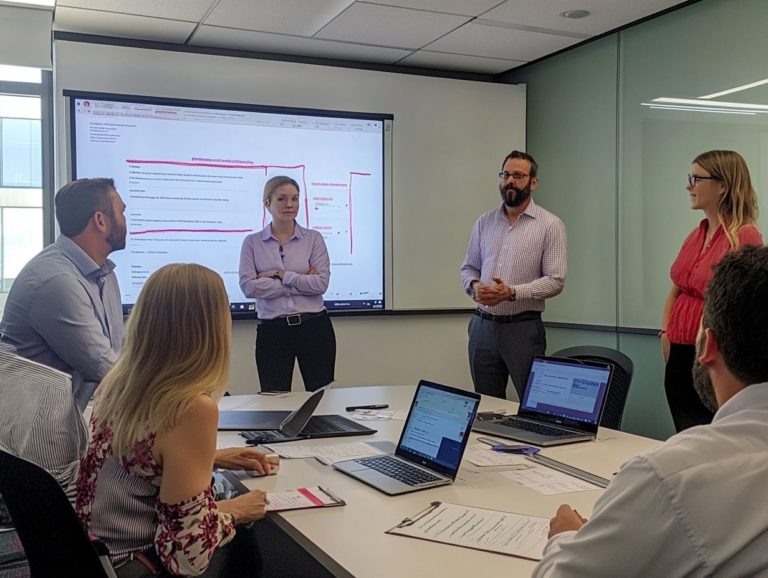Exploring Employee Perspectives on Performance Management
In today’s dynamic workplace, understanding performance management is essential for cultivating a motivated and productive team.
This article explores the importance of employee perspectives in shaping effective performance management strategies. It outlines common challenges organizations face and examines various methods for gathering insights.
You’ll find practical recommendations for enhancing performance management that empower you to create a more engaged and committed workforce.
Contents
- Key Takeaways:
- The Importance of Employee Perspectives
- Common Challenges with Performance Management
- Methods for Gathering Employee Perspectives
- Key Findings from Employee Perspectives
- Improving Performance Management
- Frequently Asked Questions
- What is performance management?
- Why is it important to explore employee perspectives on performance management?
- What are some common employee perspectives on performance management?
- How can organizations gather employee perspectives on performance management?
- What are some potential benefits of exploring employee perspectives on performance management?
- How can organizations use employee perspectives to improve their performance management process?
Key Takeaways:

- Employee perspectives are crucial for identifying and addressing issues in performance management.
- Gathering insights through surveys and interviews is essential for improvement.
- Implementing changes based on feedback can lead to better employee satisfaction and performance.
What is Performance Management?
Performance Management is a strategic approach that integrates various organizational processes to enhance team performance and individual contributions. It aligns your goals with the broader mission of the organization.
As organizations move away from traditional methods, they recognize the vital role leadership plays in fostering open communication. Effective feedback allows you to measure performance and develop skills.
By integrating performance metrics into development initiatives, organizations can evaluate their employees’ skills more accurately. This modern approach cultivates an engaged workforce and creates a continuous learning environment, which is essential today.
The Importance of Employee Perspectives
Employee perspectives cultivate a culture of engagement and retention. They provide insights into workplace culture and management strategies.
Understanding employees’ viewpoints enhances supervisor relationships and promotes collaborative goal-setting, boosting performance.
When you prioritize employee engagement, you create an attractive environment for top talent and professional development opportunities.
Why Employee Perspectives Matter
Employee perspectives create a feedback loop that shapes performance reviews and talent development initiatives. This feedback deepens your understanding of individual performance and highlights areas for improvement.
Organizations that actively seek and integrate employee input adapt their appraisal processes, meeting workforce needs while driving competitive performance.
By leveraging these insights, you foster openness and collaboration. This environment encourages employees to take ownership of their development and enhance their skills.
Implementing effective feedback mechanisms elevates individual performance and strengthens team dynamics. This approach keeps organizations agile and ready to adapt strategies, ensuring sustained success in challenging economic climates.
Common Challenges with Performance Management

Despite its importance, performance management systems frequently encounter a range of challenges that hinder their effectiveness, especially in traditional performance environments dominated by rigid ratings and evaluation processes.
One significant hurdle is the dependence on outdated performance metrics that overlook the dynamic nature of both individual and team performance. This shortcoming can foster feelings of inequity, as highlighted by equity theory, which refers to the balance of contributions and rewards within the workplace. Ultimately, this undermines organizational health and employee morale.
Organizations must recognize and tackle these challenges to establish a more effective performance management framework.
Identifying and Addressing Issues
Identifying and addressing issues within performance management requires a variety of strategies that incorporate ongoing development and effective feedback mechanisms. You must critically evaluate your performance appraisal processes to pinpoint specific areas that hinder both individual and team performance.
This involves not only assessing the effectiveness of your current performance evaluations but also fostering an environment conducive to open dialogue about challenges. This approach enhances overall organizational health.
To get started, conducting regular assessments can help you uncover biases or inefficiencies that may impact employee morale and productivity. By implementing structured feedback channels, you create a culture of continuous improvement and encourage employees to share their perspectives on performance norms.
Providing training opportunities that focus on skill enhancement and professional growth enables your team to better meet performance expectations. By prioritizing these initiatives, you can nurture a more engaged workforce, ultimately leading to improved outcomes and sustained organizational success.
Act now to enhance your team’s performance and morale!
Methods for Gathering Employee Perspectives
Utilizing a variety of approaches to gather employee perspectives is essential for elevating engagement and performance throughout the organization.
Surveys and interviews serve as two fundamental techniques that yield invaluable insights into employee sentiments and experiences. These methods enable you to pinpoint areas for enhancement within performance management systems.
By effectively implementing these tools, you can cultivate a culture of collaboration and transparency, ultimately propelling both team performance and individual development opportunities to new heights.
Surveys, Interviews, and Other Techniques
Surveys and interviews are essential for gathering your employees’ perspectives. These methods allow your organization to assess engagement levels and pinpoint areas ripe for improvement in performance evaluations.
By crafting comprehensive surveys that incorporate relevant performance metrics, you can glean both quantitative and qualitative insights to enrich your performance management systems.
Conducting interviews offers a deeper dive into employee sentiments, creating a space for feedback that goes beyond the formal evaluation process.
To maximize the effectiveness of these tools, you must prioritize clarity and relevance in your questions. Ensure they resonate with your employees and encourage thoughtful responses. For example, instead of simply asking if employees feel valued, consider posing the question, Can you share an example of a time when you felt recognized for your contributions? This approach sparks engaging conversations and insightful feedback.
Employing techniques such as active listening during interviews can help you uncover underlying issues that surveys might overlook. This ultimately leads to a more nuanced understanding of employee experiences and enhances overall engagement.
Key Findings from Employee Perspectives

Key findings from employee perspectives offer invaluable insights into the trends that influence the effectiveness of performance management practices within organizations. Understanding these viewpoints helps pinpoint critical areas for improvement that directly affect employee engagement and the overall health of the organization.
Leveraging these insights enables you to create tailored talent development initiatives that resonate with employee needs! This encourages ongoing growth and ensures sustained high performance.
Insights and Trends
Insights gleaned from employee feedback are essential for crafting effective performance management systems. They uncover patterns that significantly impact engagement and ongoing development.
By using these insights, you can adapt your performance management strategies to stay relevant and responsive to the evolving needs of your workforce. This proactive approach encourages a culture of continuous improvement, enhancing both individual and team performance.
By analyzing data from employee surveys and feedback sessions, you can identify areas ripe for development. This highlights what drives motivation and where employees might feel disconnected.
The implications of these insights go beyond minor tweaks; they require a comprehensive reevaluation of performance metrics to create more transparent and collaborative processes.
Establishing regular feedback loops helps you nurture a dynamic environment that fosters engagement. This empowers employees to take ownership of their growth, essential for retaining top talent and promoting a resilient workplace culture!
Improving Performance Management
Improving performance management requires embracing changes inspired by constructive employee feedback. This fosters a culture that prioritizes ongoing development.
Organizations must take proactive steps to reassess their performance management systems, ensuring alignment with the needs of both employees and the organization.
By establishing processes for continuous improvement and integrating employee perspectives, you can enhance talent development opportunities and ultimately drive superior performance outcomes.
Implementing Changes Based on Employee Feedback
Implementing changes based on employee feedback is essential for enhancing your performance management systems and improving team performance. Start by systematically evaluating feedback gathered from surveys and interviews, pinpointing key areas for improvement.
Prioritizing skill enhancement and aligning changes with employee needs creates a more agile and adaptive performance management process that drives both individual and team success.
To ensure effectiveness, involve stakeholders at all levels during the evaluation phase. This fosters a culture of openness and collaboration.
Once you ve identified core themes from the feedback, focus on developing clear action plans that outline specific steps for implementation.
Regularly tracking progress and adjusting strategies based on continuous feedback enhances skill development and bolsters employee engagement.
Integrating these updates into existing performance management systems leads to meaningful metrics that reflect both individual growth and organizational objectives, creating a more productive work environment.
Frequently Asked Questions

What is performance management?
Performance management is a process that involves setting goals, monitoring progress, and providing feedback to employees to improve their performance and achieve organizational objectives.
Why is it important to explore employee perspectives on performance management?
Exploring employee perspectives on performance management offers valuable insights into the importance of employee input in performance management. It shows how the process is perceived by employees and helps improve its effectiveness.
What are some common employee perspectives on performance management?
Common employee perspectives include anxiety about evaluations and a desire for more frequent feedback. Employees often question the fairness and accuracy of the process.
How can organizations gather employee perspectives on performance management?
Organizations can gather perspectives through surveys, focus groups, and one-on-one discussions. They should actively ask for feedback and suggestions from employees.
What are some potential benefits of exploring employee perspectives on performance management?
Exploring employee perspectives helps identify areas for improvement in the process. This approach increases employee engagement and satisfaction, leading to better performance.
How can organizations use employee perspectives to improve their performance management process?
Organizations can implement changes based on employee feedback. This includes more frequent check-ins, better training for managers, and ensuring transparency in evaluations.




